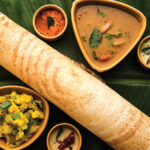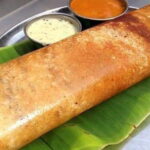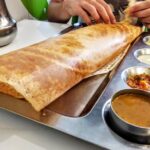Thosai: A Classic South Indian Pancake that Malaysians Love
Thosai is a classic South Indian pancake that can be savoured in Mamak stalls and Indian restaurants across Malaysia. This delightful dish is crafted from a thin batter made with fermented pulses (legumes) and rice flour, expertly cooked on a flat griddle. Thosai is typically enjoyed during breakfast and dinner, served with accompaniments such as curry, chutney, and dhal.
Originating from South India, where it is known as dosa, dosai, or dosay, Thosai has strongly influenced Malaysian Indian cuisine, which predominantly derives its inspiration from the culinary traditions of South India. This connection is deeply rooted in Malaysia’s Indian community, the majority of whom trace their ancestry to South India.
The process of preparing Thosai begins by soaking urad dhal (black gram) and fenugreek in water for six hours. Once drained, the ingredients are combined with cooked rice and water, resulting in a smooth mixture. Traditionally, a stone grinder is used to achieve an even smoother consistency. Rice flour and salt are then added to the mixture, creating a lump-free batter that is left to ferment for at least 12 hours, often prepared the night before.
To cook Thosai, a ladleful of the fermented batter is poured onto a hot griddle coated with oil. The batter is deftly spread in a circular motion from the center using the base of the ladle. When the batter forms small holes and the underside turns a golden brown, it is flipped over. The cooked Thosai can be rolled into a tube or folded into a triangle. At Mamak restaurants, it is commonly served with curries, chutneys, or dhal. Chutneys come in various flavours, such as coconut, chilli, mint, or peanut.
Thosai offers an array of enticing variations in terms of size, content, and cooking method. One popular variation is Masala Thosai, which features a mixture of flour and spiced potato filling, generously seasoned with sliced onions, chillies, mustard seeds, and cumin seeds, resulting in a vibrant yellow colour.
Hailing from Mysore in the Indian state of Karnataka, Mysore Masala Thosai incorporates a spread of butter and a mixture of chillies, garlic, and cumin known as Mysore chutney. Additional ingredients like tomatoes and beans enhance its flavour profile.
Paper Thosai, favoured by the Chinese community, is a large, crisp, paper-thin version of the standard Thosai. The batter, made from fermented ground rice and urad dhal, is cooked until crispy, resulting in delightful caramelisation and a sweet-and-sour, nutty taste. With a diameter roughly twice the size of regular Thosai, Paper Thosai is served in a cone shape, attracting eager diners.
Rava/Rawa Thosai distinguishes itself from the traditional Thosai by utilising semolina flour, which imparts a nutty flavour. Unlike regular Thosai, it does not require overnight fermentation. Cumin seeds, onions, and chillies are added to infuse the batter with aromatic spices. The result is a lighter texture and a slightly deeper colour.
Egg Thosai adds a delightful twist by incorporating scrambled eggs atop the cooking batter, resulting in a fluffy texture. Another variation, Onion Thosai, delivers a sharp flavour and rough texture as the onions are only partially cooked. In recent years, creative renditions of Thosai have emerged, including Cheese Thosai, Milo Thosai, and Banana Nutella Thosai, showcasing the fusion of traditional flavours with modern innovations.




